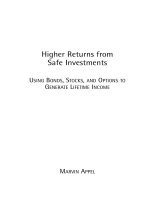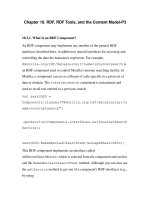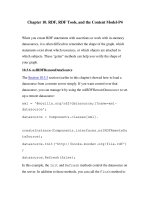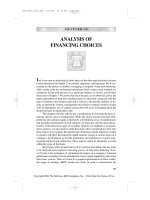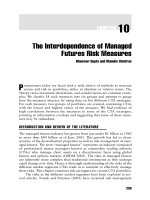Chapter 10 investments bond prices and yields
Bạn đang xem bản rút gọn của tài liệu. Xem và tải ngay bản đầy đủ của tài liệu tại đây (941.01 KB, 40 trang )
Chapter 10
Bond Prices and Yields
10.1 Bond Characteristics
10-2
U.S. Credit Market Instruments O/S 2008 Q3
U.S. Equity Market (Common) $19,648 Billion
U.S. Credit Market Debt $51,796 Billion
Debt by Selected Major Borrowers:
U.S. Government Securities $13,850 Billion (27%)
(Includes Agency & GSE)
%s are percent of Total U.S. Credit Market Debt, source is Federal Reserve Flow of Funds
10-3
U.S. Credit Market Instruments O/S 2008 Q3
By Selected Major Borrowers
Corporate & Foreign Bonds $11,262 Billion (22%)
Municipal Bonds $2,669 Billion (5%)
Mortgages $14,720 Billion (28%)
10-4
Bond Characteristics
Bond: A security that obligates the issuer to make specified payments to the holder over a period of time.
- Face or par value
- Coupon rate: Determine interest payment
Zero coupon bond: Issued at prices considerably below par value.
- Maturity
10-5
Treasury Notes and Bonds
T Note maturities range up to 10 years
T bond maturities range from 10 to 30 years
Make semiannual coupon payment.
Bid and ask price
- Quoted in dollars and 32nds as a percent of par
EX) 100:10 = 10010/32 = 100.313% of par value = $1,003.13
-
Typical par = $1,000
Yield to Maturity
: Interpreted as a measure of the average rate of return to an investor.
10-6
Figure 10.1 Prices and Yields of U.S. Treasuries
10-7
Corporate Bonds & Debt
Most bonds are traded over the counter
Par = $1,000
As a general rule, safer bonds with the higher ratings promise lower yields to maturity.
10-8
Corporate Bonds & Debt
Call provisions
- Allow the issuer to repurchase the band at a specified call price before
maturity date.
- Callable bonds typically come with a period of call protection,
deferred callable bonds
.
Convertible bonds
- Give bondholders an option to exchange each bond for a specified
number of shares of common stock of the firm.
- Conversion ratio – the number of shares for which each bond may be
exchanged.
- Benefit from price appreciation of the company’s stock.
10-9
Corporate Bonds & Debt
Puttable bonds
- Allows the bondholder to extend or retire the bond at the put date.
EX) If coupon rate > current market yield, extend the bond’s life.
If coupon rate < current market yield, not extend the bond and
instead reclaims principal, which can be invested at current yields.
Floating-rate bonds
- Make interest payments that are tied to some measure of current
market rates. EX) T-bill rate + 2%
- While the bond adjusts to changes in the general level of market
interest rates, it does not adjust to changes in the financial condition of
the firm.
10-10
Preferred Stock
Like bonds, Preferred stock promises to pay a specified stream of dividends.
Unlike bonds, the failure to pay the promised dividend does not result in corpor
ate bankruptcy.
Instead, the dividends owed simply cumulate, and the common stockholders ma
y not receive any dividends until the preferred stockholders have been paid in fu
ll.
In the event of bankruptcy, the priority for the claim is as follows:
Bondholders > preferred stockholders > common stockholders
Rarely gives its holders full voting privileges in the firm. However, if the preferre
d dividend is skipped, the preferred stockholders will then be provided some vot
ing power.
10-11
Other Domestic Issuers
Federal Home Loan Bank Board
Farm Credit Agencies
Ginnie Mae
Fannie Mae
Freddie Mac
Municipal bonds: interest payments are tax-free.
10-12
Innovations in the Bond Market
Inverse floaters
- Coupon rate falls when interest rates rise & vice versa
: Investors in these bonds benefit doubly when rates fall.
Asset-backed bonds
- Income from specified assets is used to service the bond
: Coupon rate is tied to the financial performance of asset.
Pay-in-kind bonds
-
Bond issuer may choose to pay interest by giving the investor a
bond rather than cash.
10-13
Innovations in the Bond Market
Catastrophe bonds
- In the event of a specified ‘disaster’, the bond issuer’s required
payments are reduced or eliminated.
: Receive compensation in the form of higher coupon rates for taking
on the risk.
Indexed bonds
- Payments are tied to a price index or the price of a commodity.
: TIPS (Treasury Inflation Protected Securities) With TIPS the par value
of the bond increases with the Consumer Price Index.
A risk-free real rate.
10-14
10.2 BOND PRICING
10-15
BOND PRICING
10-16
•
The price depends on the value of dollars to be received in the future compared to
dollars in hand today. Present Value
•
Bond Value = Present value of coupons + Present value of par value
•
If we call the maturity date T and call the discount rate r, the bond value can be
written as
•
The first term is the PV of an annuity and the second term is PV of the final payment
of the bond’s par value.
•
Price = Coupon + Par Value
= Coupon Annuity factor(
r
,
T
) + Par value PV factor(
r
,
T
)
T
t
t
rr )(1
Par value
)1(
Coupon
P
T
1
+
+
+
=
∑
=
Bond Pricing
EX) Bond Price for a corporate bond:
C = Coupon = 10%, Interest rate = YTM = r = 12%, Maturity = N
or T = 10 years, P = price, Par = $1,000
What is the bond’s price using semiannual compounding?
64.8% 35.2%
10-17
[ ] [ ]
NT
rr
2
2N
1T
)2/(1
Par
)2/(1
(C/2)
P
+
+
+
=
∑
=
{ }
$885.30 $311.80 $573.50P
=+=
20
20
1T
T
)06.(1
$1,000
)06.(1
$50
P
+
+
=
∑
=
Bond Pricing
At a higher interest rate, the PV of the payments to be receive
d by the bondholder is lower. Therefore, the bond price will f
all as market interest rates rise. the main source of risk in t
he bond market.
10-18
10.3 BOND YIELDS
The current yield of a bond measures only the cash income provided b
y the bond as a percentage of bond price and ignores any capital gains
or losses.
We may want to measure the rate of return that accounts for both curre
nt income as well as price increase or decrease over the bond life.
YTM is the standard measure of the total rate of return.
10-19
Bond Prices and Yields
Prices and Yields (required rates of return) have an inverse relationship.
When yields get very high, the value of the bond will be very low.
When yields approach zero, the value of the bond approaches the sum of the cash
flows.
10-20
YTM is the discount rate that makes the present value of a bond’s payments eq
ual to its price.
YTM is often viewed as a measure of the average rate of return that will be earn
ed on a bond if it is bought now and held until maturity.
Find the YTM for a 8% coupon, 30-year bond selling at $1,276.76.
Annual percentage rate or APR = 3% X 2 = 6%
Effective annual yield = $1 X (1.03)2 -1 = 0.0609 = 6.09%
Promised Yield to Maturity (YTM)
10-21
[ ]
[ ]
60
60
1T
r/2)(1
$1,000
r/2)(1
$40
76.276,1$
+
+
+
=
∑
=
T
year -halfper %3)2/(
=
r
[ ] [ ]
NT
rr
2
2N
1T
)2/(1
Par
)2/(1
(C/2)
P
+
+
+
=
∑
=
Figure 10.3 The Inverse Relationship Between B
ond Prices and Yields
Click to edit Master text styles
Second level
Third level
Fourth level
Fifth level
10-22
Current Yield
Annual dollar coupon divided by the price
Premium bonds (bonds selling above par value)
- Coupon rate > Current yield > Yield to maturity
Discount bonds (bonds selling below par value)
- Coupon rate < Current yield < Yield to maturity
10-23
10.4 BOND PRICES OVER TIME
10-24
Premium and Discount Bonds
Premium Bond
Coupon rate exceeds yield to maturity
Bond price will decline to par over its maturity
Discount Bond
Yield to maturity exceeds coupon rate
Bond price will increase to par over its maturity
Can you explain why these price change will occur?
10-25

